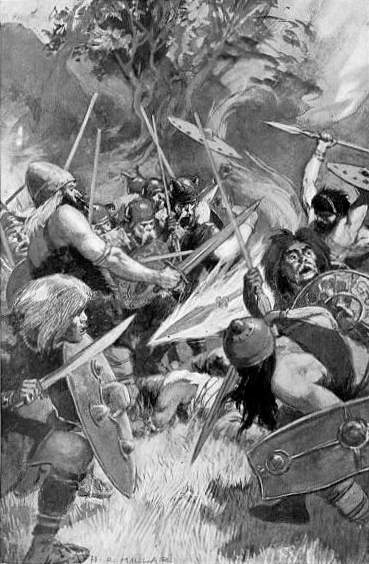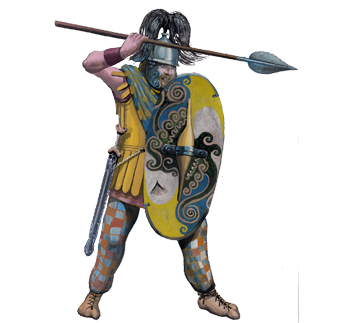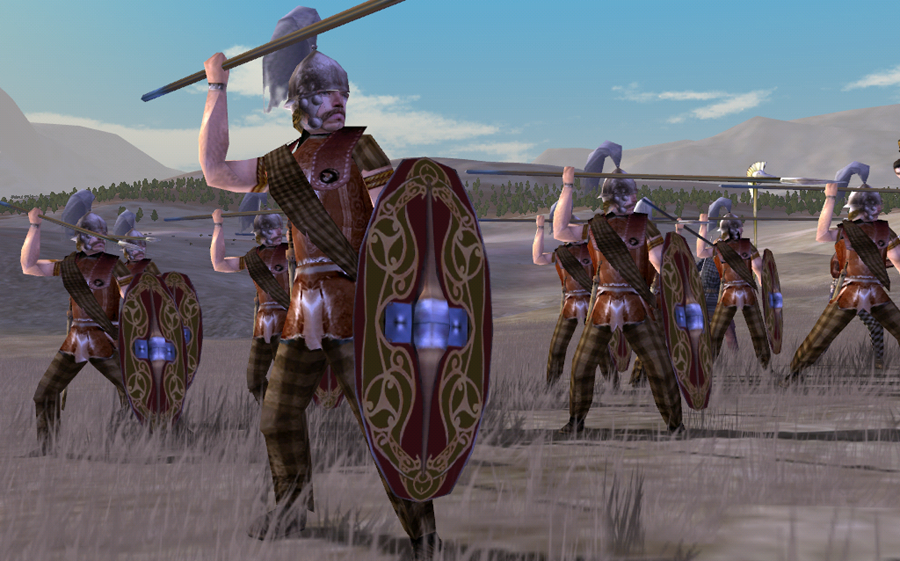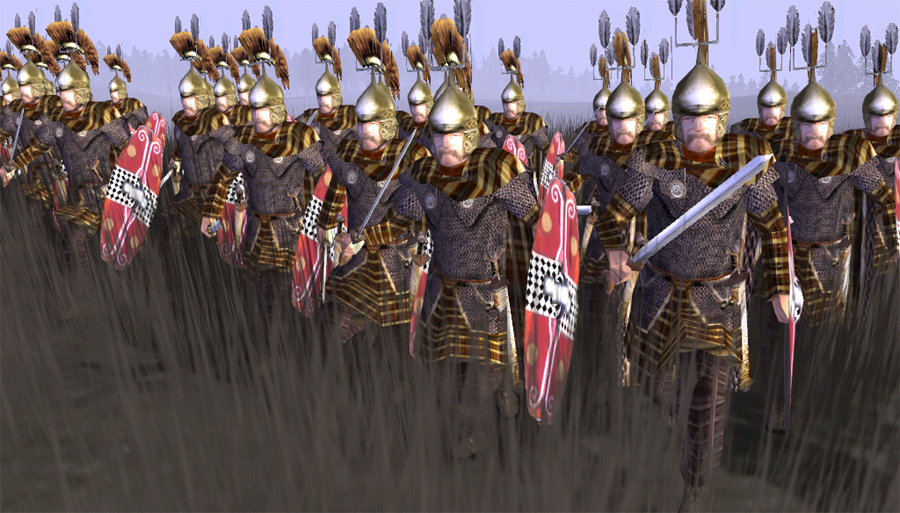
From Homeric times
The "champion" is on of the most recoignisable figure of ancient litterature. Assimilated to the hero at first, it mingled with the very begining of litterature itself. Story to inspire, it was a biography. No tother than the greatest figure of Sumerian, pre-biblical times: Gilgamesh. The king inspired many semi-mythology stories which evolved into the myth of Herakles in the Greek classical world. This story was written between XVIIIᵉ to the XVIIᵉ centuries BC. Hercules (Herakles) was allegedly born in Thebes (which shields would bear from then on the famous club and sometimes a lion's head pelt.His story is intermingled with Greek gods and mythology. The story percolated through this classic culture was stil very vivid and present until the end of the Hellenistic era and the rise of the Roman Empire. Meawnhile the Bronze real war of the Aegean, cenetered around the siege of Troy by a coalation led by the king of Mycenes, probably had its roots in resources-gathering, namely around the control of the Bronze trade and Troy was very much also a gateway to trade in the east, notably very lucrative silk and spices road. These are necessary to enter the minds of ancient civilizations, which stories of heroic deeds and examples to follow inspired the youth of their times, and infused through most of the most brillant military minds of ancient history, from Hannibal to Caesar, through Alexander the Great and Pyrrhos.

The Champion in Celtic tradition
Heroes and champions existed probably at a very early age, and although there are little to no written records of known and recoignised "champions" of ancient times, the tradition survived through early medieval litterature or Ireland and Scotland. Ireland in particular had many such characters in its folklore, notably the Tuatha De Danaan story. One of the most prominent figure was Lugh, a demi-god, and its "magical spear", and his celebrated son, the hero Cú Chulainn, hammer bearer.The tradition also percolated in Germnic folklore with figures such as Beowulf (The mythologized story of a "champion" of the dark age norse). Lug was the provierbial Celtic god of war, akin Thor/Donar in the old norse mythology. Hercules also mixed with the Celtic tradition, as through a marriage with the daughter of a Gallic chieftain gave him a son, Galatès, seen as the ruler of the Gauls or eponym. It's difficult to summup the range of connections between the old Mediterranean mythologic stories and Celtic tradition, but through the Rhodanian valley, thee stories very much made their way into Celtic/Gallic culture of the time, through the druids. These stories were just too great to miss.
The Trojan war heroes are also seen as a source of origin for many cities myths, like the origin of Rome, through the Trojan hero Aeneas, and his descendents, sons of Mars, Romulus and Remus. Northwards, Ogmios, a renowned hero and speaker was said to be derived also from Hercules. There was also a link between renowned cavalry warriors and Epona, goddess of the horse. It was often represented with the sun symbol, the ancient spoked wheel, also found on the celtic chariot. The latter was often the mount of choice for a champion. It was a status symbol, related to the old Trojan tradition, despite the purely military and usable character of the war chariot. The status was even echoed in Gallic and Celtic in general banquet practices: The meat cuts reflected the stature and prominence of the guest, as the choicest pieces were awarded to the favorite warriors, the champion’s portion, which could be possibly disputed by other warriors, leading to arguments and guests brawl, possibly a part of the "show".

Celtic tradition
Due to the lack of evidence before the Gallic wars, we can only rely of Imperial era tradition in spared, pagan areas like Welsh, Scottish and in Particular Irish Celtic traditions and literature. They gave clues about thes ancient aristocratic military elite that ruled their nations from Oppida (Fortresses). It seems however in light of modern Historians than the heroic tradition has complicated relations with this ancient military aristocracy. Its most visible translation in the "real world" seems to have been through the Champion, or Cavaros. Here (below), a depiction of a "Cavaros", acting as personal bodyguard. It is often reported about ancient Gallic battle lines the presence of a chieftain or a King and his champion(s) as well as his Solduroi, close bodyguards, fiercly loyal.
The figure of the Champion is not totally free of the Heroic myth forged by the Homeric tradition, but since nothing passed through the Greek-Roman tradition it's difficult to assess its influence. The "campio" in Latin is not derived from a Greek word, which had many names for the equivalent of a champion: ἀθλητής, or ὑπέρμαχος or ὑπερασπιστής depending on their role and attributes; Some associated it with the "epilektoi" (elite) but it has in reality a weaker sense.
Both the Bythonic and Goidelic (ancient Irish) litteratures are filled with examples of both ancient champions and heroes, beyond Cuchulain, such as the Pan-Gaelic Finn Mac Cumaill and the Pan-Brythonic Taliesin. It is certain that some aspects of a cult of the hero/champion could be seen through rich burial, taste for rich objects, refined workmanship of armour, helmets and weaponry, and chariots kept inside these tombs, there to recall this status in the afterlife.
The Cavaros in battle
There are two Gallic translations for a Champion, one stronger than the other. The "Argos" which is close to argoi, "noble" is also the heroic elite. It's the summum of military aristocracy. It was a "champion" before holding power by himself, becomng a chieftain, whereas the Cavaros is not empowered other than through his connections, and through reputation. The cavaros is in general younger, but depended upon a protector, the chieftain or noble "argoi", himself a former champion. The Cavaros has a particular status. This was a picked-up man already part of the client network of a noble, king of local chieftain. He was remarked and rewarded for his prowesses and enjoyed a special treatment which set him apart from the common elite.
Cavaros from the Senones (in reality, they would have been spread out rather than closed in a short space, way too precious to be targeted by archers and slingers).
In the Gallic clientelism system the Cavaros (plural Cavaroi) was neither a solduros (death-loyal bodyguard), an ambactos (servant bodyguard), but rather a chosen elite among the professional warriors, the cingetoi. He was in a sense a "Uercingetoi", an elite within warriors already, but one step further. A champion was probably remarked, chosen and held by his master, benefactor and protector to defy and won over the other side own champion in the Homeric tradition, be an example for others, and boost morale of its own side. In the ancient tradition, when two great armies faces themselves, a battle of attrition to the exhaustion through carnage of one or the other side was not always the solution. Oherwise, as ancient texts testified, war being endemic, yearly, populations would have been systematically reduced down to extinction. Instead, the ancient Greeks coded it as part as the civilization they shared. It was almost ritualized, perhaps due to the influence of the Olympic games. There was even a well-known military Olympic contest, the Hoplomachia, or "race with arms". Like in a game, or rugby pack, two melees of Hoplites decided of the fight after a short and decisive engagement, under the vigilance of the Umpire, a kind of "arbiter", and under the sounds of trumpets and flutes. The first culprit was casualties were low. It was not rare to see ordinary citizens going to war yearly and always returning to tell the story. It was almost a condition to citizenship.
In a more ancient tradition, probably widespread as it was known by numerus cultures outside the Celts, and bronze age Greek cultures as well, the "Champion" of a king of chieftain could single-handedly decide of the fate of the battlefield, sparing the whole army a vicious fight. Egalitarism in the Greek classic society meant the champion disappeared whereas it survived in other traditions still valuating individual bravery. Heroes and Champions now belonged to the mythos, inspiring, but no longer modern in the Hellenic culture. Neither of the ancient Hellenic authors related the fate of individual champions, but rather the deeds of the rulers.

Argoi (Nobles) - Their equipment was similar to their own elite Cavaros - The best available, with well-visible helmet decorum.
With its non-egalitarian, deeply hierarchical culture, the Celts however still valued elites and champions, notably through clientelism, which would have been seen as a form of corruption to ancient greeks. The Romans, a bit in between, however still valued the champions and individual bravery, as an example. The earliest ones were the likes of Horatius. Individual bravery was remarked even through the unformity of the legion, as reported by Julius Caesar in his "De Bello Gallico" with the Centurions Titus and Pullo. The Centurion in fact was the personnification of championship through the legion and th cement of the legion was the possibility of advancement through individual bravery, even though the roman war machine was well oiled and do not required free elements to stand up too much.
In the end, since there are no written records of the numerous wars between Gallic Nations, confederations and tribes, it is difficult to assess the true nature of the Cavaros, other than an asset which can be used to provoke an enemy in duel and killed him, the fate being the satisfaction of one side against the other, or just a morale booster before battle. If the Champion won, this favored its side, as the gods shown clearly its support, whereas if the Champion was killed, either this would lower morale, or in the contrary motivate troops for vengeance. Whatever the case, most authors suspects a Gallic battle line always comprised at least one cavaros. If kept in reserve it was likely to be the "supreme bodyguard" of the chieftain.

Cavaros armament and equipment
Individual bravery and skills were promoted and cultivated among the Gauls. This did not prevented common tactics like the shieldwall, and organized battlelines, especially in early times with the use of the Lancia favored over the sword, reflected in later changes in the suspension system (see Andre Rapin study). In this early battle line of La Tene era circa 400-300 BC, the nobles (Argoi) and their own Ambactoi, the chieftain (Cingetorix, Tigernorix, or Vellaunos) and his Cavaros, took place on the central part, in the very front of the battleline instead of retired as a reserve. They were surrounded however by massed of professional warriors, the Cingetoi. In the Gallic logic, this military aristocracy only retained power through military prowesses, inspiring by their example, and therefore needed to lead from the front. It's not surprising given their foes, like the Romans, certainly also led by the example and from the front, like Casear, Marius, Pompeius, Camilius and many others that never hesitated to take part in the fight personally. It was part of the "geste" of any aspiring general in Rome, earning their triumph, and reputation in general to aspire later to the greatest political honors. This "geste" was more to gain popular support rather than seduce the Senate.In the same way for the Gauls, loyalty from warriors, which were not rewarded directly by their nobles (outside the inner client circle), only held by the example. In this tradition, Champions were a guarantee of this loyalty, even more if this allowed the nobles to be a bit less prominent in the fighting. Their military valor and reputation at large was carried by this Cavaros and allowed them a less "heroic" and dangerous stance. This was especially true when these Nobles fought on horse (which most warriors could not afford), or from a chariot, saved from harm and more remote from the fight. At least, his ambassador close to his foot soldier was the Champion, looking for the unwavering support of his army.
Since there is no indication in a sense or the other, than the Champion could be either a horseman, a footsoldier or even a charioteer, it was in any case probably equipped like the elites. As soon he was chosen and picked-up, lavishly awarded, a Cavaros was probably superbly equipped with a costly chainmail rather than a simpler composite-leather armor, having a longsword also, an efficient and why not decorated iron helmet. Armament would have varied along the tactics of the times. An early Cavaros of La Tene, around 300-400 BC probably fought on foot alongside the others nobles and elites, using the three meters long lancia and then reverting to the sword. If duelling, no doubt the sword and potentally javelins (Gaisos) were preferred to the cumbersome Lancia. As for the sword, it is possible that in the later La Tène era, an increasing population would have led to larger armies favoring spearmen in close orders and leading to a decline in the importance of the champion with his sword - and thus in sword functionality.
 A Briton chieftain, in front of his oppida, and behind him a single spear carrier, which could be either an ambact, or a champion, or both. Indeed in smaller-scale fights, a local chieftain would have just chosen a warrior, down to a simple armor, if any, and in the contrary naked and tattoed to impress, and using a short lance, a sword, an axe, a club or hammer, most probably the latter. The "Batoroi", chosen for their strenght would have probably constitute the primary reserve in which picking up a local, village champion. On the level of a small time in an oppida, no doubt a better equipment, armor, sword and helmets would have been part of the panoply. Also the Champion's helmet, either when duelling naked or with full armor in a melee, would have likely be heavily decorated, with plumes, crests, feathered and painted in bright colors on 'masts' as those founds in early examples of the Montefortino style. A Champion needed to be seen from afar, raising above the melee, like a reassuring sight during the fury of the battle.
A Briton chieftain, in front of his oppida, and behind him a single spear carrier, which could be either an ambact, or a champion, or both. Indeed in smaller-scale fights, a local chieftain would have just chosen a warrior, down to a simple armor, if any, and in the contrary naked and tattoed to impress, and using a short lance, a sword, an axe, a club or hammer, most probably the latter. The "Batoroi", chosen for their strenght would have probably constitute the primary reserve in which picking up a local, village champion. On the level of a small time in an oppida, no doubt a better equipment, armor, sword and helmets would have been part of the panoply. Also the Champion's helmet, either when duelling naked or with full armor in a melee, would have likely be heavily decorated, with plumes, crests, feathered and painted in bright colors on 'masts' as those founds in early examples of the Montefortino style. A Champion needed to be seen from afar, raising above the melee, like a reassuring sight during the fury of the battle.

Angus Mc bride's famous illustration of a small group of warriors charing. This clearly shows a wealthier, more lite warrior leading from the front, surrounded by less-well equipped followers. This could well be the appearance either a a champion and his own retinue or a lesser noble. The chainmail, longsword, and feathered, tall and visible helmets are also clue of his status.

Another famous Mc bride's illustration showing a heavy cavalryman, possibly a noble, a Gaisatoi and a lesser rank warrior in the 20d-3nd century, possibly the relating the invasion of the Balkans. A champion, when used to provoke the enemy into duels, could well be fighting with the bare minimum as a psychological tactic and to inspire own ranks. A true champio, trained by the Chieftain own swordsmaster could have been proficient with a spear, javelins and sword as well. Also, since no celtic helmet had survived from this era, we can only guess the decorative motives on these, possibly a symbol related to the tribe, and the status of a Champion.
Sources/Read More
Google Books - Celtic Culture: A-CeltiAbout the Curadmir
Arbre Celtique - Functions
Social Mobility in Late Antique Gaul - Strategies and Opportunities (Google Book)
early celtic social structures
Gallic social structures
Ancient military hierarchy of the Gauls
♕ Aquitani & Vasci ♕ Celts ♕ Indo-greeks ♕ Veneti ♕ Yuezhi ♕ Indians ♕ Etruscans ♕ Numidians ♕ Samnites ♕ Judaean ♕ Ancient Chinese ♕ Corsico-Sardinians
⚔ Cingetos ⚔ Immortals ⚔ Cavaros ⚔ Cataphract ⚔ Romphaiorioi ⚔ Chalkaspidai ⚔ Devotio Warrior ⚔ Scythian Horse archer ⚔ The Ambactos ⚔ Iberian warfare ⚔ Illyrian warriors ⚔ Germanic spearmen ⚔ Carthaginian Hoplite ⚔ Thracian Peltast ⚔ Caetrati ⚔ Ensiferi ⚔ Hippakontistai ⚔ Hastati ⚔ Gaesatae ⚔ Cretan Archer ⚔ Thorakitai ⚔ Soldurii ⚔ Iphikrates ⚔ Kardaka ⚔ The thureophoroi